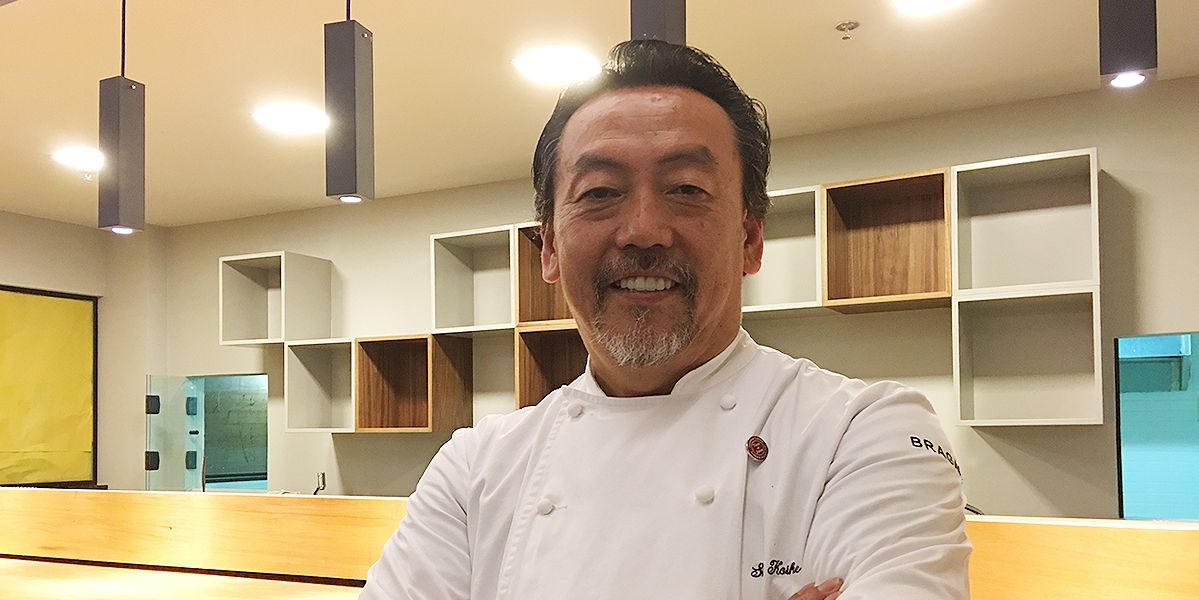
Close Up Chef Shinya Koike
Profile:Owner and chef at Aizome and Sakakura A1, which are Japanese restaurants in San Paulo, Brazil.
Interview
- Q:What sent you to Brazil?
- A:One of the seniors I used to have worked with asked me to help him open his restaurant in Brazil when I was 36. Although we started researches and preparation in the country, he didn’t open his restaurant. I stayed in Brazil, and have been a chef here since for over 20 years now.
- Q:What are ingredients uniquely seen in Brazil and how do you use your ingenuity to produce Japanese cuisines?
-
A:In fact, many Japanese vegetables (locally produced) are seen quite often in San Paulo, Brazil. But they have only a few kinds of seafood.
It is only recent that Japanese cuisines have been accepted by locals. Because we can only find the same seafood within the limited types, I try to use different preparation and cooking methods to enhance deliciousness, and also try to create different crunchiness.
- Q:What are issues on ingredients and seasonings in Brazil?
-
A:It is difficult to find real, authentic soy sauce.
Although locally produced soy sauce has been seen for reasonable prices, the deliciousness of cooked fish, etc. cannot be enhanced with these soy sauces. -
Also, not many restaurants make ‘real’ broth using konbu kelp and bonito. Although the country does not have the culture of using broth, a main issue here is that high quality kelps and bonitos can hardly be found in Brazil.
Hope the situation will change in the future.
- Q:What would you like to try in the future?
-
A:The current trend of Japanese food in Brazil only focuses on sushi and sashimi. I want to deliver the depth of the whole Japanese cuisines to local people. To make that happen, I am going to nurture the skills of local chefs. It is important to increase the level of professional chefs as well as to create a base, where their achievements are acknowledged.
I know this may sound strange, but I want to nurture the quality of customers as well. I believe the more the customers understands the deliciousness and techniques of authentic Japanese cuisines, the more the professionals will have chances to prove their skills.I will expand these two factors at the same pace. This is, I believe, how a real development of Japanese cuisines can happen.
-
We are going to open a new restaurant in September, at which an open kitchen is placed. This is my aim to produce a chance to people to watch and learn how Japanese cuisines are made.To my joy, there has been an increase in the number of young local chefs, who want to learn the true depth of Japanese cuisine – not just sushi and sashimi. Along with the fact, more local customers go overseas and experience real Japanese cuisines.
-
I hope the number of these people continue to increase to expand the base of the development of Japanese cuisines.
Moreover, events like this (Taste of Japan in Rio de Janeiro), in which local Brazilian people see and experience Japanese cuisines made by chefs from Japan, is a great idea, and I, as one of the people carrying out activities in overseas, would like to produce an opportunity like this.
- Q:What were the most difficult experiences in your business in Brazil in the last 20 years?
- A:There were only a handful of Japanese restaurants 20 years ago seen only in limited areas including the Japanese town in San Paulo.
- These Japanese restaurants were not really authentic for Japanese people as they were run by immigrants from Japan. I wanted to run a modern Japanese style restaurant here on my own.
- Q:How do local Brazilian people respond to Japanese cuisines?
-
A:Basically, not many people in Brazil know authentic Japanese cuisines because Japan is a far foreign country for them. Unfortunately, those non-authentic Japanese cuisines that have been seen there for long time or strange Japanese food cooked by Brazilians are often accepted as usual Japanese cuisines.
-
Some have thought dishes we cook are not Japanese cuisines because the tastes are different to those of home cooking by old Japanese immigrants, who live in the country for years. Also, because not many know about Japanese culture itself, those Japanese dishes, made by local Brazilians for a commercial purpose, including gyoza dumplings, fried noodles, shimeji mushrooms fried with butter, etc. have been regarded as Japanese food.
-
Moreover, local people prefer strong tastes. Especially, they like salty flavor, therefore they thought authentic Japanese cuisines made by professionals like us were said that the taste is too light.
Brazilians do not eat raw food, and some restaurants serves sushi after deep frying them (tempura).
There is a word called “Sushi Carioca”, which refers to well-cooked, deep fried sushi. (not raw).
Profile
Owner and chef at Aizome and Sakakura A1, which are Japanese restaurants in San Paulo, Brazil.
2016 Japanese Cuisine Goodwill Ambassador of MAFF
Chairperson of the Japanese Food Promotion Committee in Brazil.
Koike is a representative Japanese chef in Brazil, whose restaurant has been selected as the best Japanese restaurant in a famous gourmet magazine called Veja de Sao Paulo.
Through his attempt to fulfill his mission to expand the demand of Brazilians for Japanese cuisines while delivering the beauty of Japanese food culture, Koike provides authentic Japanese cuisines and designs creative meals skillfully using local ingredients from all over Brazil. He has been highly acknowledged.
Koike was born in Tokyo in 1957.
